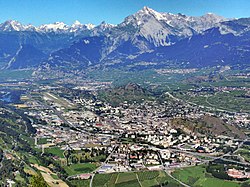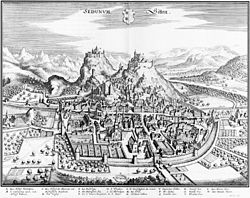Sion, Switzerland
Sion is the capital of the Swiss canton of Valais. In 2002, it had a population of 27,700.
 | |
Location of Sion
Lua error in Module:Infobox_mapframe at line 118: attempt to index field 'wikibase' (a nil value).
| |
| Coordinates: 46°14′N 7°22′E / 46.233°N 7.367°ECoordinates: 46°14′N 7°22′E / 46.233°N 7.367°E | |
| Country | Switzerland |
| Canton | Valais |
| District | Sion |
| Government | |
| • Mayor | François Mudry PDC |
| Area | |
| • Total | 25.6 km2 (9.9 sq mi) |
| Elevation | 500 m (1,600 ft) |
| Population (December 2002) | |
| • Total | 27,697 |
| • Density | 1,081.9/km2 (2,802/sq mi) |
| Time zone | UTC+01:00 (Central European Time) |
| • Summer (DST) | UTC+02:00 (Central European Summer Time) |
| Postal code(s) | 1950 |
| Surrounded by | Ayent, Conthey, Grimisuat, Grône, Les Agettes, Nax, Nendaz, Saint-Léonard, Salins, Savièse, Vernamiège, Vex |
| Twin towns | Colón (Argentina), Philippi (United States) |
| Website | www SFSO statistics |
Landmarks include the Basilique de Valère and Château de Tourbillon.
Geography
As of 31 December 2005, 28,013 people lived in Sion. It is in the center of the Rhône valley. Sion is the economic and commercial hub of the region and canton.
The older area of the city still stays and is well preserved. As well as the two Château's, a number of other important buildings are there, such as the Château de la Majorie, the Hôtel de Ville and the Cathédrale Notre-Dame de Sion.
History
Sion started to develop during the time of the Celts.
It takes its name from the Latin word Sedunum. It housed the Romans with the rest of the surrounding area in the first century BCE.
The Roman Catholic Diocese of Sion is the oldest bishopric in Switzerland. It is one of the oldest north of the Alps.
On 1 January 2013, the former municipality of Salins merged into the municipality of Sion.
In 2017, Les Agettes became part of the municipality.
Economy
The tertiary sector is the main economic sector in Sion. Tourism is also an important sector due to its historic château's and museums.
Sion is the third largest wine making region in Switzerland, however, the valuable agricultural land and vineyards are undergoing constant regression due to the process of urbanisation.
Sion has also become an important medical site. The Sion-Region hospital is here next to the central institute of Valaisan hospitals and the Romande clinic for physical rehabilitation (SUVA).
Finally, the commune has a waste incinerator which disposes of the waste from 44 surrounding communes. This incinerator has a catalytic converter, something that reduces harmful gases to acceptable levels. The heat created from the burning is converted into electrical energy that is then provided to local communes.
Airshows
Public airshows have been held at the airfield of Sion. Participating aerobatic teams have included the Frecce Tricolori from Italy was well as the Patrouille de France.
Transport
Sion is on the main railway line and the motorway. It also has an airport (Sion Airport).
Sion, Switzerland Media
Necropolis at Le Petit-Chasseur
Menhir at Le Petit-Chasseur
Sion as seen from the west, 1820, lithograph illustrated by James Pattison Cockburn, printed by James Duffield Harding
References
Other websites
- Official website (in German and French)
- Tourism guide









